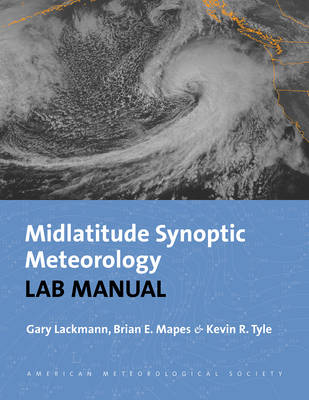
Synoptic–Dynamic Meteorology Lab Manual – Visual Exercises to Complement Midlatitude Synoptic Meteorology
Seiten
2017
American Meteorological Society (Verlag)
978-1-878220-26-4 (ISBN)
American Meteorological Society (Verlag)
978-1-878220-26-4 (ISBN)
- Titel z.Zt. nicht lieferbar
- Versandkostenfrei
- Auch auf Rechnung
- Artikel merken
Designed for use with "Midlatitude Synoptic Meteorology", this lab manual and DVD help reinforce lessons on synoptic-dynamic meteorology, synoptically driven mesoscale phenomena, numerical weather prediction, ensemble prediction, and more. It guides students in using contemporary observation and computing techniques to create forecasts.
One of the greatest challenges facing atmospheric science instructors is helping students link theoretical and mathematical concepts to the real atmosphere. The past decade has been characterized by remarkable advances in meteorological observation, computing techniques, and data-visualization technology. However, the benefit of these advances can only be fully realized with the introduction of a systematic, applied approach to meteorological education that allows well-established theoretical concepts to be used with modernized observational and numerical datasets. This lab manual is a tool designed just for this purpose; it links theoretical concepts with groundbreaking visualization to elucidate concepts taught in the companion textbook by Gary Lackmann, Midlatitude Synoptic Meteorology, the most current text available on modern weather forecasting techniques. When used in concert with Lackmann's book and the companion CD of lecture slides, this lab manual will guide students in using contemporary observational and visualization techniques to provide in-depth understanding of fundamental concepts and serve as a catalyst for student-led innovation and application.
With topics considered in an order that reinforces and builds upon new knowledge in meteorological observation and analysis, these materials will help students to deepen their understanding of synoptic-dynamic meteorology, synoptically-driven mesoscale phenomena, numerical weather prediction, ensemble prediction, and more, and put this understanding into practice.
One of the greatest challenges facing atmospheric science instructors is helping students link theoretical and mathematical concepts to the real atmosphere. The past decade has been characterized by remarkable advances in meteorological observation, computing techniques, and data-visualization technology. However, the benefit of these advances can only be fully realized with the introduction of a systematic, applied approach to meteorological education that allows well-established theoretical concepts to be used with modernized observational and numerical datasets. This lab manual is a tool designed just for this purpose; it links theoretical concepts with groundbreaking visualization to elucidate concepts taught in the companion textbook by Gary Lackmann, Midlatitude Synoptic Meteorology, the most current text available on modern weather forecasting techniques. When used in concert with Lackmann's book and the companion CD of lecture slides, this lab manual will guide students in using contemporary observational and visualization techniques to provide in-depth understanding of fundamental concepts and serve as a catalyst for student-led innovation and application.
With topics considered in an order that reinforces and builds upon new knowledge in meteorological observation and analysis, these materials will help students to deepen their understanding of synoptic-dynamic meteorology, synoptically-driven mesoscale phenomena, numerical weather prediction, ensemble prediction, and more, and put this understanding into practice.
Gary Lackmann is professor of atmospheric sciences in the Department of Marine, Earth, and Atmospheric Sciences at North Carolina State University. Brian E. Mapes is professor of meteorology and physical oceanography at the Rosenstiel School of Marine and Atmospheric Sciences of the University of Miami. Kevin R. Tyle is a senior programmer analyst in the Department of Atmospheric and Environmental Sciences at the University of Albany, State University of New York.
| Erscheint lt. Verlag | 31.10.2017 |
|---|---|
| Verlagsort | Boston |
| Sprache | englisch |
| Maße | 214 x 278 mm |
| Gewicht | 392 g |
| Themenwelt | Naturwissenschaften ► Geowissenschaften ► Meteorologie / Klimatologie |
| ISBN-10 | 1-878220-26-8 / 1878220268 |
| ISBN-13 | 978-1-878220-26-4 / 9781878220264 |
| Zustand | Neuware |
| Informationen gemäß Produktsicherheitsverordnung (GPSR) | |
| Haben Sie eine Frage zum Produkt? |
Mehr entdecken
aus dem Bereich
aus dem Bereich
Grundlagen – Maßnahmen – Planungen
Buch | Hardcover (2021)
Springer Fachmedien Wiesbaden GmbH (Verlag)
CHF 209,95
A User Guide for Offshore Renewables and Oil & Gas
Buch | Hardcover (2024)
Whittles Publishing (Verlag)
CHF 78,55
das Wolkenbuch für alle
Buch | Softcover (2024)
Seifert Verlag
CHF 27,95


